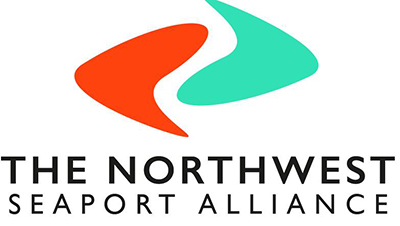Pacific Rim News: Northwest Seaport Alliance Update
John Wolfe, CEO of The Northwest Seaport Alliance (NWSA) sat down with Logistics Management editors.

 2017 was a good year for John Wolfe, CEO of The Northwest Seaport Alliance (NWSA). Not only did the Alliance earn the highest West Coast port ranking in Logistics Management’s “Quest for Quality” survey, but the man himself was saluted shortly thereafter by the Containerization & Intermodal Institute with the prestigious “Connie Award” for his achievements as well as the progress the alliance has recently made. As 2018 gets underway, Logistics Management sought to gain and share insights on how the NWSA is evolving.
2017 was a good year for John Wolfe, CEO of The Northwest Seaport Alliance (NWSA). Not only did the Alliance earn the highest West Coast port ranking in Logistics Management’s “Quest for Quality” survey, but the man himself was saluted shortly thereafter by the Containerization & Intermodal Institute with the prestigious “Connie Award” for his achievements as well as the progress the alliance has recently made. As 2018 gets underway, Logistics Management sought to gain and share insights on how the NWSA is evolving.
Logistics Management (LM): Can you describe the greatest obstacles The Alliance first faced as it got underway?
John Wolfe: I appreciate the foresight and innovative approach of our two commissions [Seattle and Tacoma] to form The Northwest Seaport Alliance. The structure of the joint venture was unique, so we had no road map to follow. We had to create it from scratch, which was a bit like building a bicycle while you’re riding it.
We also had to bring together two different cultures that served two very different counties to create one new organization with a more regional view—and we did this in the midst of a tumultuous time in the shipping industry. We encountered bumps in the road, yet by staying focused on the business and creating opportunities for our customers, we’ve come a long way in two short years.
LM: Do any of those impediments still exist? Have new ones surfaced?
Wolfe: Certainly change can be difficult, yet we must continue to evolve and improve the model. We’re still aligning systems and adjusting the functional organizational structure to increase efficiency and improve on the services we provide to our customers. Given the rapid changes in the shipping industry, though, we’re already benefiting from having a wider portfolio of facilities to offer customers as well as the opportunity to leverage our investments more strategically together instead of competing against each other.
The investments we’re making in Husky Terminal and Terminal 5 to make them big-ship ready are good examples of where we have been able to direct our investments. And our operations service center, with input from stakeholders throughout the supply chain, will continue to give us a more holistic view for efficiencies throughout the supply chain.
LM: There’s ongoing speculation about restructuring the North American Free Trade Agreement (NAFTA). Is the Alliance concerned about the consequences of a renegotiated deal?
Wolfe: We’re situated in one of the most trade-dependent states in the U.S., with an estimated 40% of jobs in Washington related to trade. I can’t speculate on what terms might change in NAFTA, but we will continue to advocate for trade policies that open new markets and level playing fields for Washington businesses that use the NWSA as their international gateways.
LM: As the hemisphere’s fourth largest ocean cargo gateway, does NWSA compete on different footing when it comes to ports in Canada?
Wolfe: The intention of the ports of Seattle and Tacoma in forming NWSA was to compete more effectively with Canada and other gateways rather than competing against each other. We speak with a strong, unified voice in advocating for reforms to the Harbor Maintenance Tax, which continues to put our gateway at a disadvantage with Canadian ports serving the same U.S. Midwest market. The U.S. tax policy provides little benefit to our naturally deep harbors for the money our customers pay.
LM: Finally, we hear a great deal of talk about the “digitization” of ports and terminals. Is this just buzz, or is the Alliance embracing new technological advances?
Wolfe: Our customers want to have greater visibility to the real-time movement of their cargo through the supply chain, and we intend to be part of the solution. We’re exploring technologies and other ways we can improve the efficiency of our gateway, including intelligent transportation systems (ITS), radio frequency identification (RFID) tags and mobile applications.
The challenge is to balance the cost with the benefits. In the meantime, we have created an operations service center with metrics set through feedback from our customers and stakeholders. Gaining visibility throughout the supply chain is the first key to improving its efficiency.

Article Topics
Columns News & Resources
Latest in Materials Handling
Registration open for Pack Expo International 2024 Walmart chooses Swisslog AS/RS and software for third milk processing facility NetLogistik partners with Vuzix subsidiary Moviynt to offer mobility solutions for warehouses Materials Handling Robotics: The new world of heterogeneous robotic integration BSLBATT is looking for new distributors and resellers worldwide Lucas Watson appointed CSO for Körber’s Parcel Logistics business in North America Hyster recognizes Dealers of Distinction for 2023 More Materials HandlingAbout the Author
Subscribe to Materials Handling Magazine

Find out what the world's most innovative companies are doing to improve productivity in their plants and distribution centers.
Start your FREE subscription today.
April 2024 Modern Materials Handling

Latest Resources










